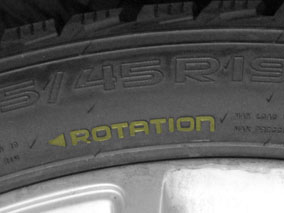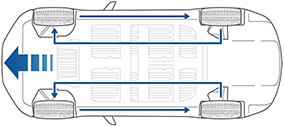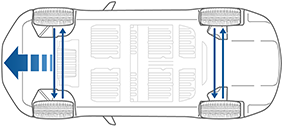Tesla Model S: Wheels and Tires
Tire Rotation
Periodic tire rotation increases the service life of tires. Tesla recommends tire rotation at 6,250 mi (10,000 km) intervals.
Tire Rotation Patterns
The appropriate tire rotation pattern depends on the design of the tire. Check the sidewall to see if there is an arrow showing a specific rotation direction. If so, the tire is directional. When the vehicle is traveling forward, these tires must roll in the indicated direction.

Directional Tires
To rotate directional tires that are the same size, move the rear wheels to the same positions on the front. Move the front wheels to the same positions on the rear. Do not move the wheels from left to right.

Non-Directional Tires - All Tires the Same Size
Most original equipment tires for Model S are non-directional and are the same size on the front and rear of the vehicle. To rotate non-directional tires that are the same size, move the rear wheels to the same positions on the front. Move the left front tire to the right rear, and the right front tire to the left rear.

Non-Directional Tires - Different Tire Sizes Front and Rear
Model S Performance Plus uses different size tires on the front and rear, which cannot be rotated front to rear. If the tires are non-directional, they can be rotated from side to side.

Installing New Tires
The vehicle ride quality and handling are maximized when all 4 tires are the same age, model, and tread depth. Rotating tires regularly allows them to wear at the same rate so that they can be replaced at the same time.
If tires have not been rotated regularly, it is possible that only 2 tires need to be replaced. If only 2 new tires are installed, the new tires must be installed on the rear of the vehicle. In wet conditions, the tires that have less tread have less traction than the new tires. Reduced traction at the front of the vehicle leads to understeer, which most drivers are better able to react to than the oversteer that would result if the worn tires were on the rear of the vehicle.

